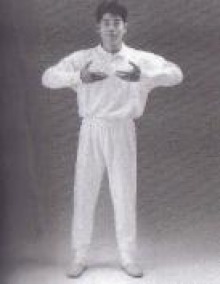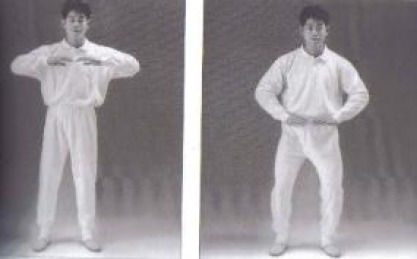Qigong
"Qigong (pronounced chee-gong) is a form of Traditional Chinese Medicine that combines breathing, posture, and movement to generate internal energy, restore health, and promote a sense of well-being."
Qigong breathing and forms help to: energise and clean the body organs of toxins; relieve backache, headaches and tension; quiet the mind; enhance deep breathing; and promote a harmonious state. There are various movements for different organs such as kidneys, lungs, liver, etc. Below are some movements from "Qigong for health & vitality" by Michael Tse. That book and Tse's "Qigong for healing & relaxation" are available for free download - just click on the title name (they are high quality ebooks; much better than the images below).
The books show more forms than are posted here and contain information about the body channels that Qi (energy) flows along. These channels relate to acupuncture points, some of which are mentioned below. This page is simply an introduction to get you started.
(NOTE: This page is a work in progress.)
"Chinese believe that if there is a problem, like a stiff shoulder or back, we should move more to heal it. When we move, we increase the circulation and allow more Qi to come in to help alleviate the problem. However, Western medicine may tell you not to move at all or to wear a support. People will often tell me that their doctor said they should not move the part of the body that they are having problems with. Some even tell me that their doctor has urged them to have surgery to 'fix' the muscle or painful joint. I have had many people come to me after surgery to ask for help as their problem became even worse. This kind of radical intervention will often make the problem worse, as it means that little or no Qi will go to that area for healing. Even if a joint is locked, we should try to move as much as we can. This means Qi will still go to that area to help heal the problem. The more Qi, the more we can move. The more we move, the more Qi can go there. Whereas, if we cut the joints and tendons, this also cuts the channels which are roadways for Qi and blood. This then makes healing much more difficult and can mean even more stiffness and pain."
From 'Qigong for Healing and Relaxtion.'
Extracts from 'Qigong for Health and Vitality'.
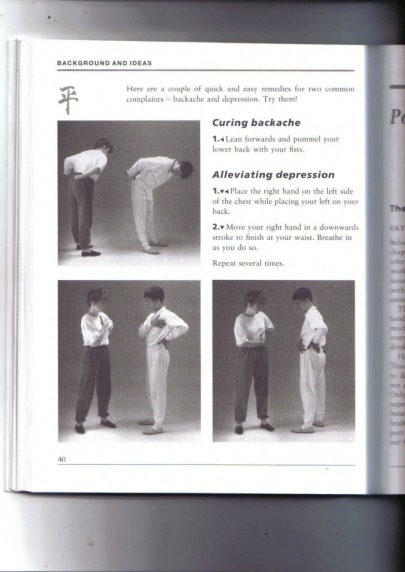
Here are a couple of quick and easy remedies for two common complaints -backache and depression. Try them!
Curing backache
1. Lean forwards and pummel your lower back with your fists.
Alleviating depression
1. Place the right hand on the left side of the chest while placing your left on your back.
2. Move your right hand in a downwards stroke to finish at your waist. Breathe in as you do so.
Repeat several times.
Holding the Dantien
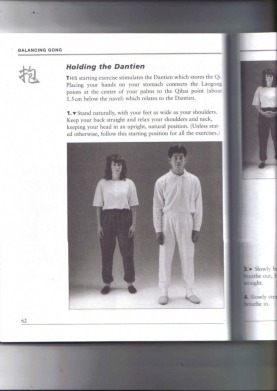
THIS starting exercise stimulates the Dantien which stores the Qi. Placing your hands on your stomach connects the Laogong points at the centre of your palms to the Qihai point (about 1.5 cm below the navel) which relates to the Dantien.
1. Stand naturally, with your feet as wide as your shoulders. Keep your back straight and relax your shoulders and neck, keeping your head in an upright, natural position. (Unless stated otherwise, follow this starting position for all the exercises.)
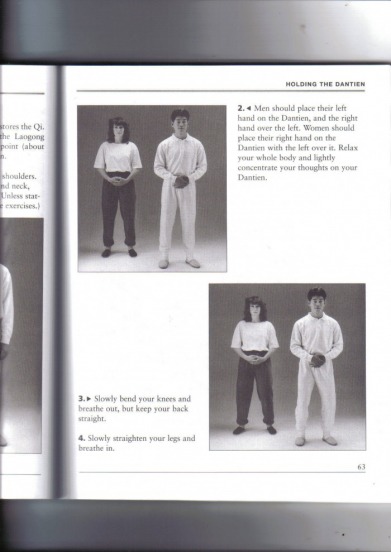
2. Men should place their left hand on the Dantien, and the right hand over the left. Women should place their right hand on the Dantien with the left over it. Relax your whole body and lightly concentrate your thoughts on your Dantien.
3. Slowly bend your knees and breathe out, but keep your back straight.
4. Slowly straighten your legs and breathe in.
THE DANTIEN - UP AND DOWN
THIS is good for your lungs, increases your breathing and stimulates your Dantien Qi by moving up and down.
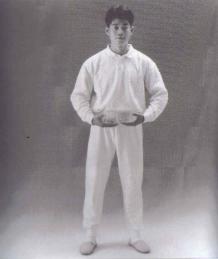
1. Stand as in Step 2 of the previous exercise.
2. Separate your hands so the palms face upwards and the fingertips point towards each other. The hands should be level
with the Dantien.
Turning the head and twisting the tail
THIS is good for the kidneys and helps you lose weight. Breathe in on either side, but breathe out on the opposite.
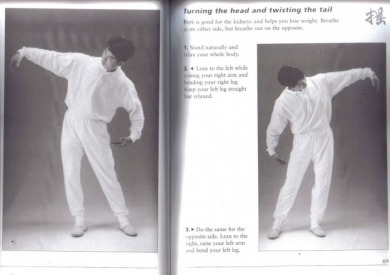
1. Stand naturally and relax your whole body.
2. Lean to the left while raising your right arm and bending your right leg. Keep your left leg straight but relaxed.
3. Do the same for the opposite side. Lean to the right, raise your left arm and bend your left leg.
BIG BEAR STRETCHES
THIS movement 'rotates' your spine, shoulders and neck. When performing the exercise your internal organs move and so are exercised. The movement concentrates on the heart and stomach and strengthens your spine, shoulders and neck.
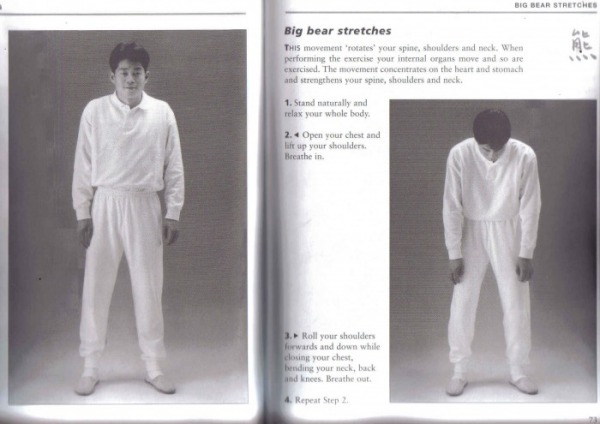
1. Stand naturally and relax your whole body.
2. Open your chest and lift up your shoulders. Breathe in.
3. Roll your shoulders forwards and down while closing your chest, bending your neck, back and knees. Breathe out.
4. Repeat Step 2.
